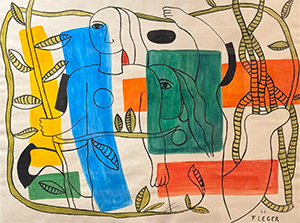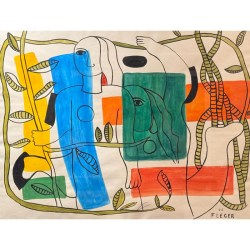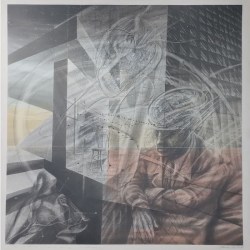Bio

Fernand Léger (1881–1955) was a French painter, sculptor, and filmmaker, widely recognized as a key figure in the development of Cubism and modern art. Born in Argentan, Normandy, Léger initially trained as an architect before pursuing art. His early work was influenced by Impressionism, but by 1910, after encountering the work of Picasso and Braque, he developed his own bold, mechanistic take on Cubism, often referred to as "Tubism" due to his distinctive use of cylindrical forms.
Léger served in World War I, an experience that deeply influenced his artistic vision. After the war, his work embraced themes of modernity, industry, and the working class, often depicting machines, urban landscapes, and everyday people in a vibrant, graphic style. He was also an innovator in film, notably collaborating on the avant-garde short Ballet Mécanique (1924).
In the 1920s and 1930s, Léger's work reflected his interest in the harmony between man and machine, a fascination shaped by both his wartime experience and the rise of industrial society. He became associated with the Purist movement and also contributed to the development of modern design. His compositions often juxtaposed flat, geometric shapes with three-dimensional forms, creating a dynamic tension that was uniquely his own. During this time, he also taught extensively, influencing a new generation of artists with his theories on color, form, and public art.
Fleeing Nazi-occupied France in 1940, Léger spent several years in the United States, where he taught at Yale and the Art Students League in New York. He was deeply inspired by American culture and jazz, and this period saw a renewed energy in his art. Returning to France after the war, he became increasingly involved in political activism, aligning with the French Communist Party and advocating for accessible art that served the people. Until his death in 1955, Léger continued to produce large-scale murals, stained glass, and ceramic works, solidifying his legacy as a champion of modernism and a visionary of the industrial age.
Notable Awards and Exhibitions:
- Grand Prize for Painting, Venice Biennale (1950).
- Solo exhibition at the Museum of Modern Art (MoMA), New York (1935), one of the first major retrospectives of a living European modernist at the museum.
- Retrospective at Musée National d’Art Moderne, Paris (1956, posthumous).
- Participation in the landmark “Cubism and Abstract Art” exhibition at MoMA (1936), curated by Alfred H. Barr Jr.
- Léger Museum, Biot, France, opened in 1960, dedicated entirely to his work and legacy.







